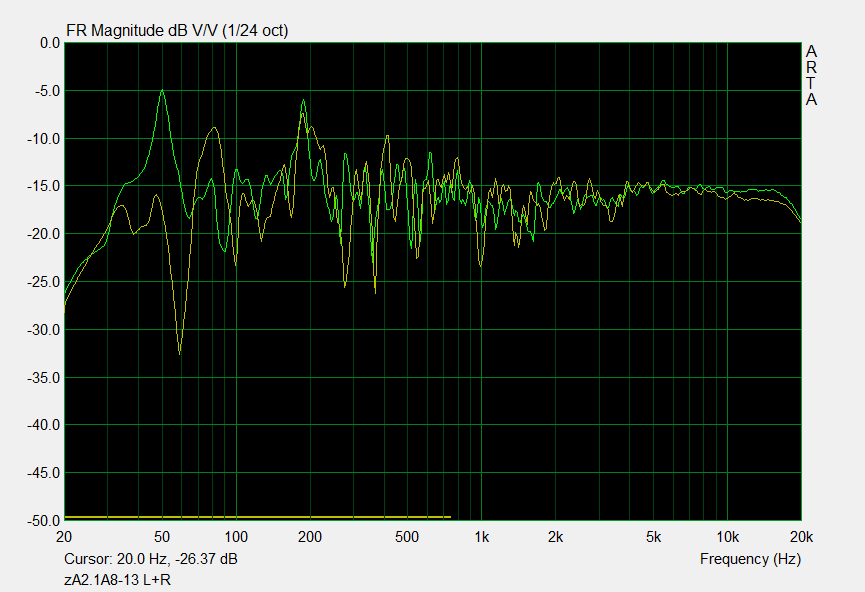
Room Correction: Benefits and Pitfalls
Room correction devices are designed to at least partially mask a room's problems without actually correcting them, so the term room correction may have been invented as a distraction from that fact. Although you can help one type of room problem in a limited way by altering the signals to the speakers, it's not a good first line of attack, and this article talks about why.
For those tempted to get on my case about being oversensitive to a semantic issue, bear with me -- room correction has many drawbacks compared to addressing the actual issues with rooms and speaker setups. Furthermore, when steps are taken to improve the room itself, then a room correction device will have much less work to do, and this will minimize its drawbacks.
As a matter of definition, rooms correction comprises an automated equalizer that listens to the sound at a certain spot or range of spots in a room, and makes adjustments to the speakers’ frequency response.These adjustments mask the room’s frequency response problems for listeners that keep their heads where the microphone(s) had been placed.
Of course, one can get marked improvements in frequency response flatness from equalization (EQ), and flatness is a key element of accurate sound. On the other hand, at least for masking room or speaker problems, automated EQ systems have the following drawbacks:
- EQ treats only one of several symptoms of room problems, namely frequency response. It treats no diseases, as it were, of the physical room itself, namely whatever are its less than ideal acoustics. In addition, room correction improves the sound only in certain positions within the room. In contrast, careful placement of speakers and the addition of room treatments will improve the sound within the entire room, and do so without the side effects that come with EQ, as discussed just below.
- Automated EQ smooths out frequency response anomalies without considering the causes. These systems don't distinguish between the natural outcomes of speaker operation in rooms, which should be left alone, vs. room and speaker problems that should be addressed judiciously. Such adjustments are best done by hand, once one is well versed in the process (or by an AI algorithm as yet unknown to me).
- The effects of the room may seem technically adverse when viewed on a spectrum analyzer, but are in fact a large part of what makes the music sound natural and lively in a room, at least when excited by a speaker with a reasonably flat frequency response. Most importantly, smoothing out these effects has an effect that I call sucking the life out of the music. Secondly, piling such EQ on top of a speaker’s innate or EQ-compensated frequency response can result in degraded speaker performance, primarily in terms of transient response and secondarily dynamic range.
- Rooms with frequency response problems tend also to have time domain and reflection problems that degrade imaging and transient response. The presence of substantial room reverberancy also dilutes and thus degrades the experience of recorded venue ambiance. These effects cannot be addressed by way of EQ.
- EQ is unable for example to treat the transient response degradation caused by resonant room modes and the standing waves that they lead to, but simply puts less energy into them; the modes are still there and they still resonate.
- Room modes are not evenly distributed around a room. EQ has the intended effect on room mode masking for just a single or small range of seating and speaker positions. It must be redone anytime there’s a change to either. Also, frequency response away from the target position(s) will be worse than it was before the EQ was applied. Systems that strive to compensate multiple positions do so by not compensating any single position very well, but averaging the amount of EQ over that area.
- EQ can degrade the transient response by applying sharp adjustments for filling response dips and thereby introduce response effects that can sound nasal, cupped hands-like, hooty, tweety, etc.. Although most automatic systems are smarter than that, it is impossible for an automatic system to know the difference between adjustments that makes physical sense and those that would be detrimental.
- EQ potentially overdrives the signal chain when filling dips in the frequency response, and in such cases will reduce dynamic range.
- Some systems introduce audible hiss or other noise.
- Equalizers put owners at the mercy of the device’s A/D and D/A conversions and circuitry. As far as I know, none are up to the latest high resolution standards. If the device includes a DAC for file playback, high resolution files that are up to these standards may be degraded; if you have an analog setup, or have a practically perfect output signal from a high resolution DAC, resolution may be lost.
- It might be awkward and complicated to operate. Some automatic units test the owner’s patience with a series of long, slow frequency sweeps for brute force response measurements, instead of an MLS or other brief interrogation, or have a graphical interface smaller than a business card, or can be operated only by way of a remote control the size of a crispy cracker that has 32 equally sized and shaped buttons on it, no tactile feedback, and slow or unreliable system response.
DIY Equalization
That said, there is a manual, rule of thumb approach that can be helpful without being harmful. First, you'll have to acquire real time analyzer software (RTA). You'll also need a means for equalizing the signal that includes parametric filters, which could be included your music player, such as in JRiver's Media Center, or be an electronic system.
First, place the microphone at your normal head position.
Then use parametric filters to tamp down the bass peaks -- those below 400 or 500 Hz -- caused by room modes and Allison effect.
Finally, to restore the overall bass level, use a low shelf filter to raise the level of the bass range below the highest frequency hump that you’ve just leveled off. Along with that, you might want to add a high pass at 20 Hz or so to avoid overloading your speakers with subsonic signals from the low shelving boost.
It’s crucial not to fill in any troughs in the bass response (or in any other range), because this adds resonances that degrade transient response and add group delay.
Contrary to that restriction, relatively shallow rises and troughs that are broad enough to span a couple or more octaves can be equalized to beneficial effect, but it’s important to ignore those that contribute to local ambiance, and it’s pretty much impossible to tell the difference without taking the speakers outdoors to determine which wiggles are from the speaker and which from the room.
Acoustic Approaches
Not to go negative on room compensation without supplying an alternative, I must point out that it's possible to reduce the effect of room modes and Allison effect with strategic speaker placement. I'll write a short piece later on about how to reduce the effect of room modes by finding and avoiding them.
True room correction, that is, treatment of the underlying sicknesses, must be done with bass traps, absorbers and diffusers. You can get most of the way to a reasonable goal with just absorbers, and these can be nothing more expensive than bats of fiberglass with decorative but thin fabric hung over them, or prefabricated absorbers available from many suppliers. Of course, doing these things right requires some knowledge and strategy, but you can count on a genuine improvement in the sound and thus your experience of the music.
Drifting Off Topic
I just have to mention the simplest EQ option, namely good old fashioned bass and treble controls. These can create helpful adaptations to room sizes and conditions, not to mention imperfect9ons in recordings, and do so without problematic side effects.
Unfortunately, tone controls fell victim long ago to a strict interpretation of the simplicity doctrine. As a result, manufacturers found or maybe just decided that they should create the impression of signal path simplicity by eliminating tone controls, even those having a bypass switch for purists, and must have welcomed the side benefit of reduced costs along with the perception of higher value.
This might be a good time to introduce another audio issue that interests me, and which will be the topic of a later article. This is exemplified by a state of affairs where many reject tone controls, yet happily employ other forms of equalization. One is present in the production and playback of vinyl records. LPs are equalized during master creation to compensate for shortcomings in that medium's available frequency response and dynamic range. Equalization is again applied by the preamp or line stage during playback to more or less reverse the original equalization. The aggregate of the two equalizations is more complex than tone controls are.
Software and equipment
Parts Express sells a pre-configured room measurement system for a reasonable price. With a little more effort, if you have a PC laptop, you can get by with a lot less money by just buying a measurement mic and TrueRTA software. You'd either use the laptop's built-in sound card, or add an external one, for which I recommend the Steinberg UR22 for its resolution and ease of use. An excellent and very affordable equalizer is the high definition box from MiniDSP. I know Behringer pro market equalizers are recommended by others, but they're no picnic to understand or program.
Peace,
David Janszen
1 Response
Leave a comment
Comments will be approved before showing up.
Also in Issues in Audio

Electrostatic Loudspeaker Attributes, the Mythic and the Mythical
Every company making electrostatics has its own approach, so each design in this category is a mixed bag of attributes -- mostly positive, some negative, and rarely indifferent.
To begin with, and probably why you’re interested in electrostatics, all offer exceptional clarity, immediacy, smoothness, low distortion, and transparency, especially in the midrange and treble. Various criticisms, however, have accumulated over the decades, spread out among a number of makers, past and present.


Arthur Vered
January 25, 2021
All good, I’ve used (very mild) manual EQ tuning for years. I used the miniDSP and am relatively satisfied with them (they have the tiniest hiss, usually unnoticed). My insistent whim is to stubbornly use “cheap” drivers for the speakers I make. Judiciously used, they can deliver very good results. What is judicious? Mostly never use/push them at, or near their extreme performance. Doubling the acreage will half the membrane travel. Quadruple it will cut travel to a quarter (or so). So multi drivers is the way to go for me (not to mention far greater power handling). 4×8″ woofers cost about a fifth of an “audiophile” one, sometimes even less. But the quality of sound is so expansive and low coloration – I happen to like it. Box volumes are larger, true, but I can live with that. 8" is about the ideal size woofer (10" is just ok) in terms of transients, acceleration and energy storing (he latter of which we want to be minimal, so they can settle quicker). Never really grasped why you started with 7" woofers, really. In my case, acreage is the name of the game, lowering IM and Doppler garbage by limiting cone travel. Obviusly the lower the travel, the more linear that movement is with less cone breakup modes. It’s important, especially when they are married to ES panels or ribbons for the rest of the frequency reproduction.
DSP xovers, mild eq and quality class D amps is the way to go, I think.